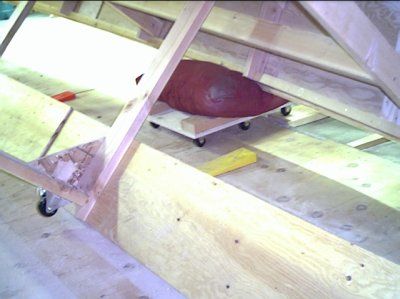Turning the Bo-Jest
by Mark Jones

After detaching the building form from any floor members, I installed casters (as pictured above) to the form and placed plastic felling wedges behind the casters. The wedges prevent the boat from rolling away from the side by which it's being hoisted (see next).

After buidling a spreader or "single tree" of laminated 2 x 6 members, I attached cross members at stations 2 & 4 (at the sheer) and using certified climbing rope rated @ 5600 pounds I attached the spalls to the spreader and began the initial hoist.

And viewed from aft.

It becomes obvious that at one time or another, the starboard sheer is going to touch the ground and so I used a cushioned caster dolly to catch and carry the sheer.

At a given point of lateral elevation, the hull tried to move in two predictable directions; the dolly began moving toward the point of hoist and the hull would eventually want to flip over out of control. Applying a comealong (as pictured) from the portside hoist pillar retarded the hull from flipping.

Here the building form is just losing touch with the ground; the dolly is starting to take over. Please note the heavy tarpaulin portside, it will be used to cushion the starboard sheer once the hull is being brought over.

A blue rope can be seen along the floor from the hoist pillar to the hull... this was to retard the hull as it raced across the floor on the dolly.

The comealong is detached, the chain hoist is gradually paid out and the hull is allowed to make a controllable rotation until the skeg touches ground.

The spreader was turned athwartships and attached once again to the spalls, the hull hoisted and a cradle installed under. And there she is... whatever her name might be.